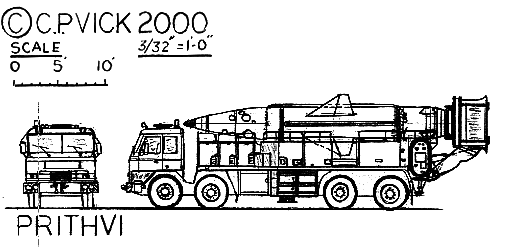|
|
|
|
|
|
|
Prithvi The Prithvi was India's first indigenously developed ballistic missile to result
from this program. The Prithvi is not a particularly sophisticated missile,
incorporating propulsion technology derived from the Soviet SA-2 surface-to-air
missile. First test-fired on February 25, 1988, two versions of this
single-stage, liquid-fuel missile are now in service and a third may be in
development. Prithvi-I (150 km/1,000 kg) in army service, is capable of striking
about a quarter of Pakistani territory, including Islamabad and most other major
cities. Prithvi-II (250 km/500 kg), in Air Force service, could strike at least
half of Pakistan, including almost all military targets of importance and all
major cities. Development of a longer-range, reduced-payload Prithvi-III (350 km
range) is suggested by some sourcesThe Prithvi-lll is apparently the naval version of the missile.
The Prithvi was India's first indigenously developed ballistic missile to result
from this program. The Prithvi is not a particularly sophisticated missile,
incorporating propulsion technology derived from the Soviet SA-2 surface-to-air
missile. First test-fired on February 25, 1988, two versions of this
single-stage, liquid-fuel missile are now in service and a third may be in
development. Prithvi-I (150 km/1,000 kg) in army service, is capable of striking
about a quarter of Pakistani territory, including Islamabad and most other major
cities. Prithvi-II (250 km/500 kg), in Air Force service, could strike at least
half of Pakistan, including almost all military targets of importance and all
major cities. Development of a longer-range, reduced-payload Prithvi-III (350 km
range) is suggested by some sourcesThe Prithvi-lll is apparently the naval version of the missile.
The Prithvi-I is small (8.55 m) and was paraded in mobile launchers during India's Republic Day parade in January 1996. The Surface-to-Surface Missile 'Privthi' developed under the integrated Guided Missile Development Programme, was successfully test launched, for the 10th time on February 7, 1993. The Prithvi-I has been test fired at least twice from mobile launchers by artillery personnel. The mobile launcher, mobile launch control and user version of the ground system including software, have been validated. Reportedly, the Prithvi-I can be armed with five different types of conventional warheads. A prefragmented warhead has been developed which has performed satisfactorily in dynamic and static trials. In May 1997 India's Junior Defence Minister V.M. Somu told Parliament that development of the 150 km-range Prithvi for the Indian Army was complete, and no test flights have been conducted since that time. Starting with a test on 27 January 1996, the Prithvi-II missile has been tested to achieve the range of 250 km with a 500-650 kg payload. On 23 February 1997 India conducted the third test of the Prithvi-II, the 16th in the overall program. And on 16 June 2000 India completed successfully its 17th test firing of the Prithvi. It is suspected that nuclear missions will be executed by the Prithvi-II. Foreign Minister Gujral said emphatically in August 1996 that the Prithvi does not have nuclear warheads, and India has consistently stated that Prithvi is to be conventionally armed. Despite repeated US pressure on India to halt the program, series production of Prithvi-I may have begun in mid-1994, and was certainly underway as of 1997, according to the 1997-98 annual report of the Defence Ministry. Orders for 100 missiles are said to have been placed by the Indian Army for its newly established 333 Missile Group, and as of 1999 as many as 75 missiles were on hand. The Indian Air Force has placed an order for 25 the longer-range Prithvi-II. It is suggested that the Indian Air Force will not be operating the Prithvi, with the few Prithvi-II missiles are at best for familiarization. The army will be operating both the SS-150 and SS-250 variants. Prithvi production capacity at BDL is approximately 3-4 missiles per month, though this has not been achieved. Production of the system has not stabilized - primarily because of cost, but also because the army is not in a rush to induct any large quantity of these missiles as yet. The Prithvi-150s were built at a cost of Rs 3 crore each. Although little has been written about the Prithvi's accuracy, India claims that it is the first indigenously produced missile with inertial guidance. Prithvi is reported by some sources to have a circular error probable of 1.5 km. 1% of range, and therefore it cannot be categorized as a precision munition. According to other sources, the accuracy of the Prithvi when fired from a pre-surveyed launch site is 10 meters at a range of 67km. From an unsurveyed site, that increases to 150-200 metres at 150km. The army wants accuracy from unsurveyed sites to be brought down to 40 metres. There is no use of any terminal guidance on Prithvi.

| |||||||||||||||||||